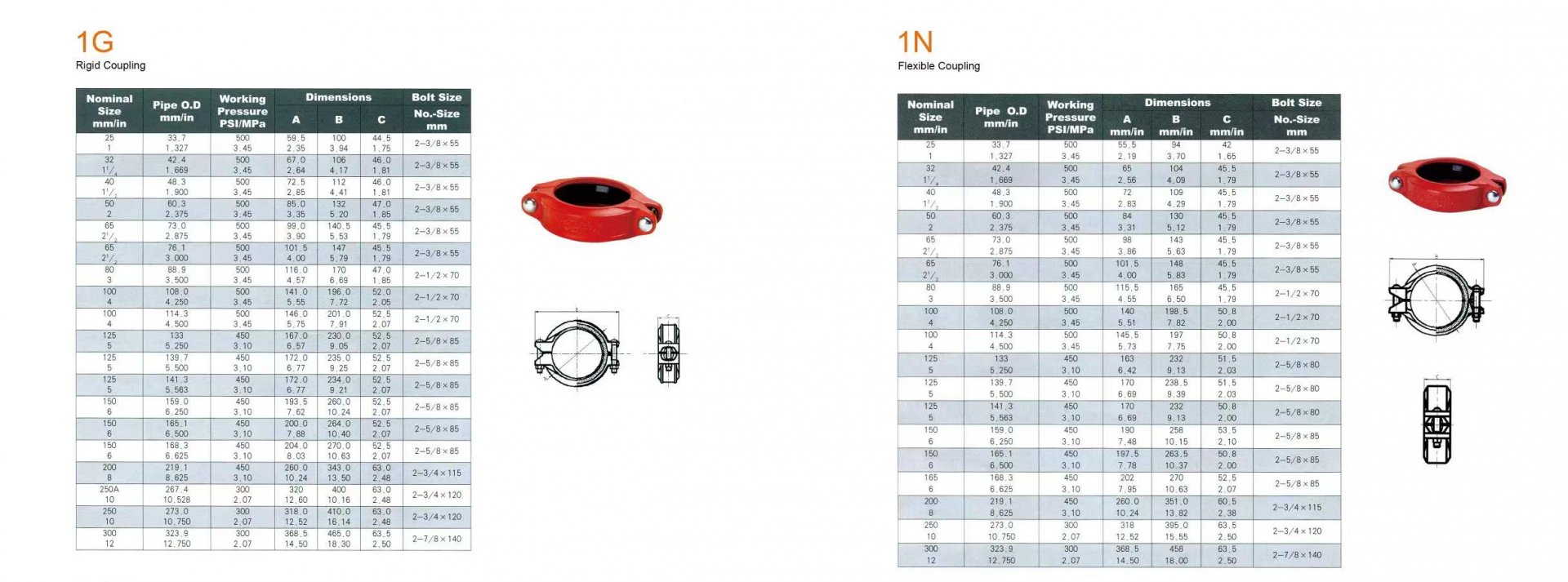Export Office: 21Floor, No.5 Nanhai Zhi Road,Qingdao, Shandong ,China
Work Shop: Beian Industrial zone, Qingdao,Shandong,China
+86 532 88550858
Martin
Inquiry now
The evolution of pipe couplings has been pivotal in various industrial sectors. The first significant innovation in this field was the grooved mechanical pipe coupling, patented by Victaulic in 1919. Initially designed as a flexible coupling, this product offered much-needed versatility across industries. It wasn’t until 1957 that the first rigid grooved pipe coupling was introduced. This article explores the key differences between rigid and flexible couplings and the implications for modern engineering projects.
Victaulic’s original patent for grooved mechanical couplings, invented by Lieutenant Ernest Tribe, marked a turning point in how pipelines were connected. The initial focus was on flexibility because industries in the early 1900s demanded alternatives to rigid joining methods like threading and flanging. This led to the invention of flexible couplings, which addressed challenges across mining, oil, gas, chemical, municipal systems, and shipbuilding sectors.

In the early 20th century, four major industries greatly benefited from flexible pipe couplings:
1. Mining: Miners required a connection method that allowed for flexibility instead of rigid threading, which was prone to breaking under stress.
2. Oil, Gas, and Chemical: These sectors often needed a flexible alternative to manage varying pressures and conditions.
3. Municipal Systems: Traditionally reliant on cast iron joints, municipalities sought a more flexible and cost-effective solution.
4. Shipbuilding: Flexible connections were essential to accommodate the natural movement of ships, making them ideal for such applications.
Though push joints (also known as bell and spigot) provided some flexibility in buried systems, they were not self-restrained and therefore unsuitable for above-ground uses. The grooved flexible coupling was the first self-restrained solution for such needs.
While flexible couplings solved many problems, their ability to allow movement also introduced new challenges. Pressurized systems with flexible couplings required additional supports to prevent expansion. In response, the first rigid grooved couplings were developed in 1957 for high-pressure oil applications where flexibility was unnecessary.
During the 1980s, lower-pressure rigid couplings gained popularity in commercial construction. Their reliability made them suitable for fire protection systems and HVAC installations.
1. Fire Protection: The demand for a rigid alternative to threading, particularly for light-wall roll-grooved pipes, led to the adoption of rigid couplings in fire suppression systems.
2. HVAC: HVAC systems required safer and faster alternatives to welding and flanging, with rigid couplings offering superior performance in certain bending applications.
Notably, in HVAC applications, both flexible and rigid couplings could be integrated, depending on the specific needs of the system. This versatility offered value-added benefits in mechanical design.
The fundamental distinction between these two coupling types lies in their performance and design:
Flexible Couplings: These allow for controlled linear and angular movement, accommodating pipeline deflection as well as thermal expansion and contraction. The key in the coupling is narrower than the groove in the pipe, allowing it to move within the groove and enabling pipe-end separation.
Rigid Couplings: In contrast, rigid couplings are designed to prevent movement entirely. They act like welded or flanged joints, with standard support and hanging requirements, whereas flexible systems demand more accommodations due to potential axial expansion under pressure.
Though rigid and flexible couplings may appear similar, their performance characteristics differ substantially. Engineers must account for these differences when designing systems, especially when movement or pressure changes are involved. Miscalculations can lead to inefficiencies or even system failures.
Grooved couplings offer numerous advantages over traditional methods like welding, flanging, or threading. They provide a quick, flame-free, and spark-free joining method, which is not only safer but also more efficient. Furthermore, flexible couplings can replace specialized movement compensators, bringing additional value to the system.
Victaulic’s couplings, for instance, are known to reduce noise and vibration more effectively than traditional equipment. This makes them a preferred choice in many applications, from industrial pipelines to commercial buildings.
For over two decades, Qingdao Fluido has specialized in providing high-quality pipe fittings, valves, and flanges. Established in 1994, the company has served clients across more than 35 countries. They offer a comprehensive range of products, from forged pipe fittings to ductile iron solutions. With stringent adherence to ISO9001 standards and partnerships with factories in Shandong and Hebei, Qingdao Fluido ensures that every product meets international quality requirements.
Whether you need custom-made flanges or reliable ductile iron fittings, Qingdao Fluido stands out as a go-to supplier for all pipe coupling needs. Their extensive expertise and commitment to quality make them a valuable partner in any large-scale project.
When choosing between rigid and flexible couplings, it’s essential to consider the specific demands of your project. Both offer unique advantages and should be selected based on system requirements, from pressure and temperature changes to space constraints. For projects requiring a mix of flexibility and rigidity, grooved mechanical couplings are ideal. Consult manufacturers like Qingdao Fluido for design assistance to ensure your system’s optimal performance.
Export Office: 21Floor, No.5 Nanhai Zhi Road,Qingdao, Shandong ,China
Work Shop: Beian Industrial zone, Qingdao,Shandong,China
+86 532 88550858
Martin
© 2020 Qingdao Fluido Industrial Co.,Ltd. All Rights Reserved. Qingdao fluido valve

